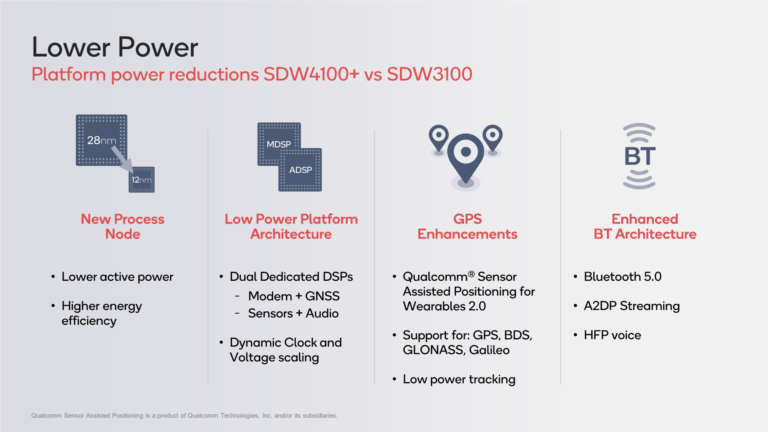The new Snapdragon 4100 and 4100+ is a Significant Leap Forward For Wear OS Smartwatches.
The newly announced Snapdragon 4100 and 4100+ could attract more manufacturers and make Wear OS smartwatches more desirable. Already, Apple is the biggest smartwatch maker and trailed by the likes of Samsung and Fitbit (acquired by Google). All of which make their own chip for their smartwatches. But there could be a new twist to smartwatch market share when the 4100/4100+ chips start gracing future Wear OS smartwatches.
Taking you back the memory lane, recall that the 2100 chip released in 2016 still powers a vast majority of Wear OS smartwatches and has seen many manufacturers leave the platform for proprietary chip and OS. Then the 3100 chip was released in 2018, it looked promising, but not much of a difference as it was relatively the same Arm Cortex-A7 that uses an outdated 28nm process node, except for the nano-sized QCC1110 co-processor that handled always-on, sport mode and battery saver. Yet only a few manufacturers like Suunto, Montblanc, Fossil, and her subsidiaries rallied around the 3100 chip. Other companies like Mobvoi released watches like Ticwatch Pro 4G and C2+ still powered by the 2100 chip
However, the new 4100/4100+ specs indicate a significant leap forward as it levels up with Apple’s S5 and Samsung’s Exynos 9110 chips, and this could attract more manufacturers to the brand and off course make Wear OS smartwatches more desirable.
Snapdragon 4100+ vs 4100 vs 3100 vs 2100 – Wear OS Chips Compared
| SNAPDRAGON 4100+ | SNAPDRAGON 4100 | SNAPDRAGON 3100 | SNAPDRAGON 2100 | |
|---|---|---|---|---|
MODEM NAME | Qualcomm® Snapdragon™ Integrated X5 LTE Global Mode modem | Qualcomm® Snapdragon™ Integrated X5 LTE Global Mode modem | Qualcomm® Snapdragon™ X5 LTE modem | Qualcomm® Snapdragon™ X5 LTE modem |
Released Date | June, 2020 | June, 2020 | September, 2018 | 2016 |
PROCESSORS | ||||
| CPU Clock Speed | Up to 1.7 GHz | Up to 1.7 GHz | Up to 1.2 GHz | Up to 1.2 GHz |
| CPU Cores | Quad-core CPU ARM Cortex A53 | Quad-core CPU ARM Cortex A53 | Quad-core CPU 4x ARM Cortex A7 | Quad-core CPU 4x ARM Cortex A7 |
| CPU Architecture | 64-bit | 64-bit | 32-bit | 32-bit |
| Process Technology | 12 nm | 12 nm | 28 nm | 28 nm |
| DSP Technology | Qualcomm® Hexagon™ QDSP6 V56 (dual; MDSP & ADSP) | Qualcomm® Hexagon™ QDSP6 V56 (dual; MDSP & ADSP) | Modem DSP | Modem DSP |
| Co-processor | Always-on QCC1110 chip (Improved and supports 64K colors) | No | Always-on QCC1110 chip | Not present |
| GPU Name | Qualcomm® Adreno™ 504 GPU | Qualcomm® Adreno™ 504 GPU | Qualcomm® Adreno™ 304 GPU | Qualcomm® Adreno™ 304 GPU |
| GPU API Support | OpenGL ES 3.1 | OpenGL ES 3.1 | OpenGL ES 3.0 | OpenGL ES 3.0 |
CONNECTIVITY | ||||
| LTE technology | LTE TDD, LTE FDD | LTE TDD, LTE FDD | LTE FDD | LTE FDD |
| Cellular Technology | TD-SCDMA, EV-DO, GSM/EDGE | TD-SCDMA, EV-DO, GSM/EDGE | WCDMA (DC-HSDPA, DC-HSUPA), TD-SCDMA, CDMA 1x, GSM/EDGE | WCDMA (DC-HSDPA, DC-HSUPA), TD-SCDMA, CDMA 1x, GSM/EDGE |
| Wi-Fi Standards | 802.11a/b/g/n | 802.11a/b/g/n | 802.11n | 802.11n |
| Bluetooth Version | Bluetooth 4.2 & 5.0 | Bluetooth 4.2 & 5.0 | Bluetooth 4.2 | Bluetooth 4.1 |
| Bluetooth Technology | Bluetooth Low Energy | Bluetooth Low Energy | Bluetooth Low Energy | Bluetooth Low Energy |
| Location Support | Qualcomm® Location | Qualcomm® Location | Qualcomm® Location | Qualcomm® Location |
| Satellite System Support | GPS, GLONASS, Beidou, Galileo | GPS, GLONASS, Beidou, Galileo | GPS, GLONASS, Beidou, Galileo | GPS, GLONASS, Beidou, Galileo |
| Terrestrial System Support | Wi-Fi, Cellular | Wi-Fi, Cellular | Wi-Fi, Cellular | Wi-Fi, Cellular |
| NFC | Supported | Supported | Supported | Supported |
| RFFE | Qualcomm® RF Front-End solution | Qualcomm® RF Front-End solution | Qualcomm® RF Front-End solution | - |
| USB version | USB 2.0 | USB 2.0 | USB 2.0 | USB 2.0 |
CAMERA | ||||
| Camera | Video Capture (30 FPS): 1080p video capture Support for up to 16 Megapixel cameras | Video Capture (30 FPS): 1080p video capture Support for up to 16 Megapixel cameras | - | - |
DISPLAY | ||||
| Maximum On-device Display Support | 1920 x 1080 | 1920 x 1080 | 640x480, VGA | 640x480, VGA |
| Display Input/Output | MIPI, SPI | MIPI, SPI | MIPI, SPI | MIPI, SPI |
| Display UI FPS | Up to 30 FPS | Up to 30 FPS | Up to 60 FPS | Up to 60 FPS |
AUDIO | ||||
| Audio Technology | Qualcomm® Voice Suite, Qualcomm® Noise and Echo Cancellation technology, Qualcomm® Voice Activation | Qualcomm® Voice Suite, Qualcomm® Noise and Echo Cancellation technology, Qualcomm® Voice Activation | Qualcomm Aqstic™ audio technology, Qualcomm® Voice Activation | Qualcomm® Fluence™ noise cancellation technology, Qualcomm® Voice Activation, Qualcomm® Snapdragon™ Voice+ |
MEMORY | ||||
| Memory Speed | 750MHz | 750MHz | 400MHz | 400MHz |
| Memory Type | LPDDR3 | LPDDR3 | LPDDR3 | LPDDR3 |
| Storage eMMC | eMMC 4.5 | eMMC 4.5 | eMMC 4.5 | eMMC 4.5 |
SOFTWARE OPTIONS | ||||
| Operating System | Supports Wear OS by Google, Event-Drive RTOS | Supports Wear OS by Google | Supports Wear OS by Google, Event-Drive RTOS | Supports Wear OS by Google |
Difference Between Snapdragon 4100 and 4100+
The difference between the Snapdragon 4100 and 4100+ is that the later comes with an always-on QCC1110 co-processor that keeps the display always-on in a low-power mode as well as extending support for sensors tracking sport modes.
So, these two are basically the same except for the QCC1110 chip that comes with the 4100+. The QCC1110 is standalone, so manufacturers can actually design apps specifically for the co-processor.
Snapdragon 4100+ (What’s New?)
- Improved CPU – 85% Increase in Performance
- Dual DSP – reduced Workload
- Dual ISP
- Improved Memory
- Improved GPU
- Improved Bluetooth
- Improved Battery Life

Instead of a 32bit Arm Cortex-A7 with 28nm process node and 1.2GHz processor, the 4100 chip is built on a 64bit 12nm process with 1.7GHz speed. This, according to Qualcomm represents an 85% increase in performance. Hopefully, the lags experienced on many Wear OS smartwatches become a thing of the past.
Secondly, Qualcomm doubled the DSPs on the 4100 chip from one QDSP V56 to two of the same QDSP V56. One is an MDSP for Modem and GPS, while the second is an ADSP for Open Sensor Execution Environment (SEE) and audio. This partitions and reduces the workload which contributes to the claimed 25% increase in battery life.
Qualcomm also doubled the ISPs to support up to 16MP camera sensor. I don’t think this is actually necessary, but going by the high demand for smartwatches for kids most of which are equipped with a camera, it could be a nice addition. Moreover, smartwatches like Kospet, Zeblaze, Lemfo, and KingWear make some of the best smartwatches with cameras. So manufacturers would probably want to improve the camera quality.
Another improvement that’s coming with the 4100/4100+ is a faster memory processor. The memory had been boosted from 400MHz to 750MHz, but still same LPDDR3 technology. LPDDR4 which is faster and low-power consuming would have been a more worthwhile upgrade. Hopefully, it gets included in the next upgrade.
The next generation of Wear OS smartwatches powered by the 4100/4100+ will have better graphics displays, thanks to the increased graphics processor. Display resolution has increased from 640 x 480 @ 60fps to 1920 x 1080 @ 30fps as a result of moving from Adreno 304 @ 400MHz to Adreno 504 @ 750MHz. This is a big move forward which Qualcomm claims represent 2.5x improvement in GPU performance. This is good news for Wear OS smartwatches as it will enable better detailed graphic display and also reduce the workload on battery and by extension longer battery life.
Another improvement that comes with the 4100 chip is the improved Bluetooth performance. While the 3100 chip supported Bluetooth v4.2, the 4100 chip now includes Bluetooth v5.0. This will mean better security and improved performance which by extension means an increase in battery life.

With the improvement in CPU, GPU and the always-on QCC1110 co-processor means extended battery life. Although, only time will tell how much improvement comes with the chip on 4100+ powered smartwatches.
What’s New For The Co-processor?

The difference between the Snapdragon 2100 vs 3100 chip is the presence of a low-power always-on QCC1110 co-processor. This is also the difference between the 4100 vs 4100+. The 4100+ comes with a QCC1110 co-processor which the 4100 lacks.
Now, the always-on QCC1110 co-processor has been redesigned to support 64k colors and also extends offload experiences to include continuous heart rate monitoring, faster tilt-to-wake responsiveness, steps, alarms, timers, and haptics.
Upcomming Snapdragon 4100+ Smartwatches
According to Qualcomm, the upcoming Ticwatch Pro 3 and Imoo Z6 Ultra as well as mentioned the Successor to Suunto 7 will be among the first set of smartwatches to be powered by the 4100+ chip.
“We applaud the ingenuity and innovation from our first of many customers, Imoo and Mobvoi,” continued Kedia, “We are pleased that these industry-leading companies are announcing smartwatches based on our Snapdragon Wear 4100 platform today and will be shipping their products later this year.” – Pankaj Kedia ( a senior director at Qualcomm)
The Imoo Z6 Ultra is expected as early as next month, while the Ticwatch Pro 3 and Suunto 7 successor will come before the year end.
Conclusion
Honestly, I think it’s right to say that, this is a big leap forward as far as Wear OS smartwatches are concerned. Although, brands like Samsung and Apple are using chips with 10nm processes nodes, but considering the jump from 28nm to 12nm, 750MHz GPU to 450MHz GPU, dual DSP, improved Bluetooth, and increased battery life. That’s a significant improvement in performance, display and longer battery life all in one. It means a lot to Wear OS smartwatches and hopefully may attract more attention to the platform while counting on Google to improve Wear OS user experience.

Hi! I’m Jude, the chief editor at Smartwatchseries.com
I’m a graduate of biochemistry, a 3D artist and a passionate fitness enthusiast. On here, I and other smartwatch fans work hard to help you find the right smartwatch for you with our guides, reviews, and comparisons.
Our aim is to become better at providing useful content, please let us know via the contact us form if there is any way we can improve.
